
views
Setting up the Cage
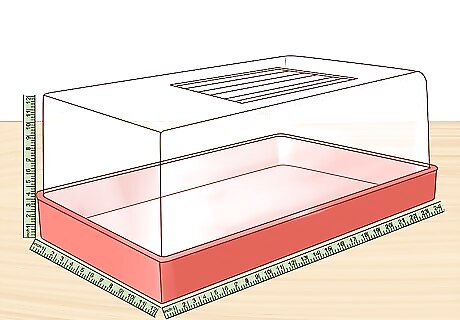
Choose a cage that's at least 2 sq ft (0.19 m) and 12 in (30 cm) tall. Hamsters love to run and climb, so the bigger the cage that you can provide for them, the happier they’ll be. A 20 US gal (76 L) aquarium is typically a good size for a hamster cage, since at a minimum all sized hamsters need at least 450 square inches of flat land to run around on. A wheel can't be used as a shortcut for that, make sure it has a secure mesh top so your hamster can’t escape. If you’re going to have more than 1 hamster, add about 1 sq ft (0.093 m) per each new member of the cage. Hamsters like a lot of floor space, so a cage with an open floor is better than a modular cage with a lot of tubes. If cages are too pricey, use a clear tote storage bin. Cut an area for ventilation out at the top, then attach wire mesh onto the hole to ensure maximum ventilation.
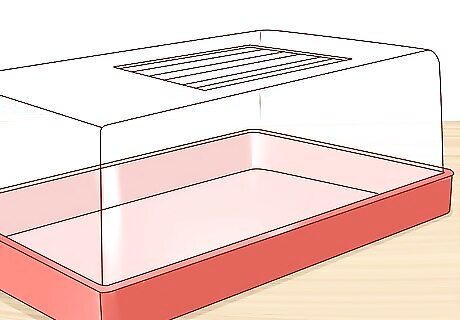
Opt for a plastic or glass cage over a wire one for safety. Some wire hamster cages are made with the bars too far apart to keep a dwarf hamster. Even if your hamster can’t get all the way out, it could squeeze its way between the bars enough to get stuck. A cage with smooth sides will prevent that from happening. Also, make sure you never use a cage with a wire floor, as your hamster’s delicate legs and feet could be injured. Make sure you spot clean the plastic or glass cage daily to remove soiled bedding. The ventilation of the cage isn't very good, so ammonia levels from the hamster's urine can build up quickly. Scoop soiled bedding and replace it with fresh bedding. Wire cages are still very popular for hamsters, and many cages are made with plastic sides with a wire insert at the top. If you do choose a cage with wire bars, make sure they're no more than about ⁄10 in (0.51 cm) apart. If you choose a cage that’s solid plastic, place a wire climbing frame against one of the walls. Being able to climb is an important part of your hamster’s daily exercise.

Place your hamster’s cage in a quiet place away from direct sunlight. Your Winter White dwarf hamster will feel safest in a spot where there isn’t a lot of noise, so don’t place it near noisy appliances, the TV, or anywhere with a lot of traffic throughout the day. Also, hamsters are sensitive to heat, so keep it away from windows where the sunlight will be strong. You should also keep your hamster cage away from where you sleep. Your hamster is nocturnal, so it will be up exercising and chewing while you’re trying to sleep. Tip: Loud noises and constant stress can affect your hamster's health. If it remains in good health, however, your Winter White Dwarf Hamster should have a life span of about 2 years.
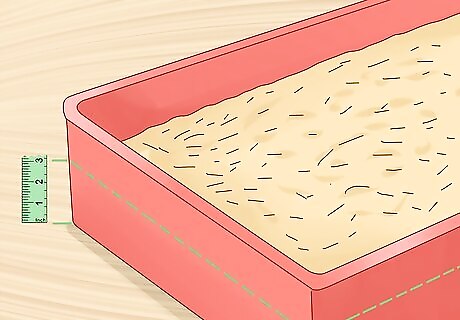
Fill the cage with a layer of bedding that’s 2–3 in (5.1–7.6 cm) deep. Purchase a soft bedding at your local pet store, and spread a generous layer over the bottom of the cage. Your bedding of choice can be made of wood shavings, shredded paper, or another fill, but avoid using aspen or pine shavings, as some hamsters may be allergic to these materials. During the winter, hamsters burrow deep into the ground to stay warm. By providing a thick layer of bedding, your pet will be able to burrow and stay comfortable.
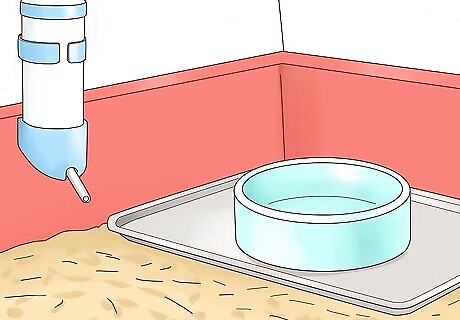
Include a food bowl and a water bottle for your hamster. If you put your hamster’s food directly onto its bedding, it will be harder to dispose of old food when you add more. To avoid this, place a shallow tray inside of the cage, and place the food on the tray whenever you feed your hamster. Also, clip a water bottle designed for dwarf hamsters onto the side of your cage. To discourage competition and aggression, add extra food bowls and water bottles if you have more than 2 hamsters.
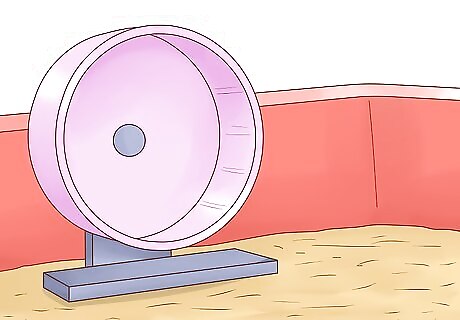
Place a solid plastic exercise wheel in the cage. Wheels made from metal rungs can cause severe damage to your hamster’s feet and legs. The safest option is a solid plastic wheel. Opt for a wheel that’s at least 8 in (20 cm), as it allows the hamster to run more naturally, instead of having to arch its back on a smaller wheel. Typically these wheels come attached to a secure base, so all you have to do is place it inside of the cage.
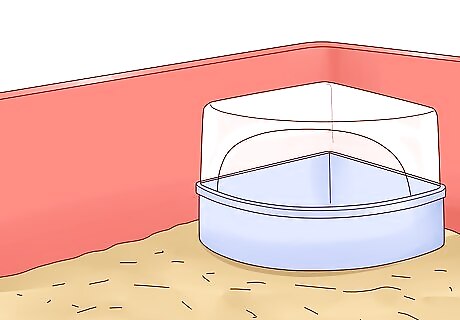
Place a tray in the corner for your hamster's bathroom. If you want to make cleaning your hamster’s cage easier, encourage it to go to the bathroom in the same spot every time. To do this, place a tray in a corner of the cage. The first time your hamster soils its bedding, put a little of the damp bedding in the tray. Your hamster will go back to this spot when it needs to go. Make sure you always wear gloves when you change the bedding.
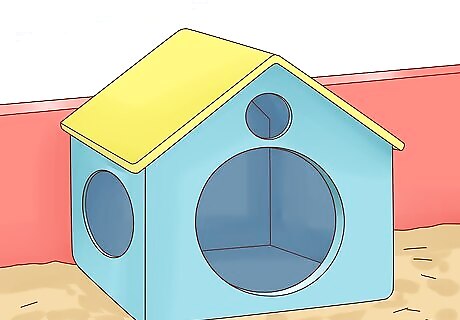
Give your hamster a place to hide. Hamsters typically hide underground or in a den when they feel threatened in the wild. To make sure it always feels safe in its new home, include a hideaway or a hamster house. Don’t be surprised if you find your hamster napping here during the day! Anytime you use plastic in your hamster's cage, including a plastic hamster house, be sure to check it regularly for signs of damage. If the hamster starts to chew the plastic, remove the item.
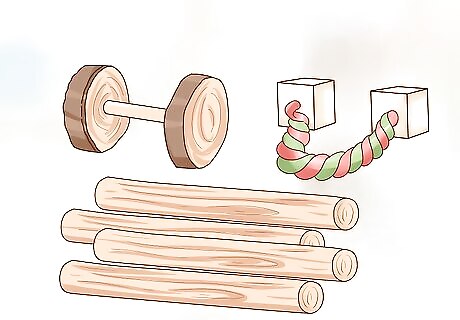
Give your hamster plenty of wooden chew toys. Hamsters’ teeth never stop growing, which can be a health hazard if they don’t have something to chew on. In the wild, they have plenty of snacks and sticks to keep their teeth filed down. Include 2-3 wooden chew toys in your hamster’s cage. Not only will this keep it healthy, but the toys will also provide your hamster with tons of entertainment! Keep extra toys on hand so you can swap them out when they need to be cleaned. Check the label to make sure that your toys weren’t treated with pesticides during manufacturing. You can also give your hamster cardboard to chew on, like an empty paper towel tube.
Interacting with Your Pet
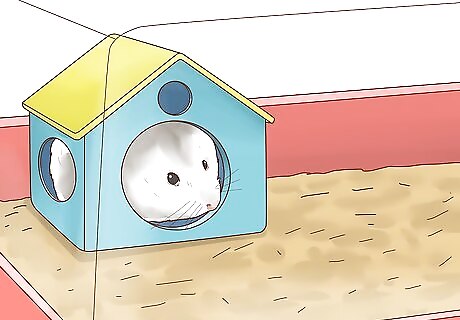
Give your hamster at least a day to settle in before you handle it. When you bring your hamster home, chances are it’s going to be pretty stressed out from traveling. Gently place it into its new home and securely shut the door, then let it acclimate for about 24 hours. That way, it will be able to explore its cage without any additional stress. Try to keep the environment as quiet as possible for that first day. Hamsters already dislike loud noises, but your Winter White will be especially sensitive during this time. If your hamster seems especially nervous or if it is still hiding after the first day, give it a few more days to get used to its new home.
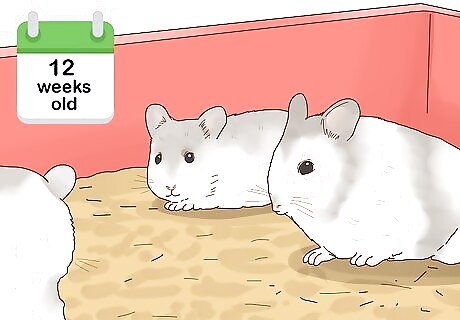
Introduce multiple hamsters before they’re 12 weeks old. If you plan to have more than one hamster, make sure they are the same sex and you introduce them as early as possible. Also, male pairs or groups are less likely to fight than females. If you see your hamsters fighting, separate them as quickly as possible. Be careful, though, as the hamsters may bite.
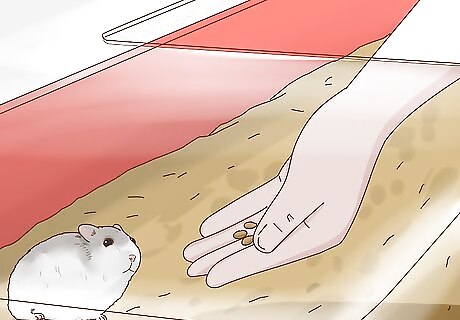
Introduce your hand slowly and offer a treat after the first day. Once your hamster seems comfortable in its new environment, open the cage and slip your hand in. Hold a treat in your open palm, and place your hand flat on the hamster’s bedding. Then, stay as still as possible, letting it come up and explore you on its own terms. Take out your hand after about 5 minutes. Remove your hand from the cage if the hamster hisses or squeaks. This is a sign that it is afraid. Tip: Since Winter White Dwarf Hamsters are nocturnal, the best time to handle them is in the evening. If you have an especially timid hamster, it may take a few sessions before it approaches your hand. Be patient, since you’re trying to build trust. Let the hamster get comfortable with your hand for a few days before you try to pet it, then wait a few more days before the first time you try to pick it up.

Scoop the hamster up from below when you think its ready to be held. Use both hands, and pick the hamster up from beneath its stomach. Cup your hands slightly so you can maintain control over your Winter White. While you’re holding your hamster, keep your hands close to the floor or a tabletop so if the hamster jumps or falls, it won't get hurt. Be gentle when you’re handling your hamster. Avoid making any loud noises, and never squeeze it. Never try to pick up your hamster from above. It will think you’re a predator, and it may bite you to try to escape.
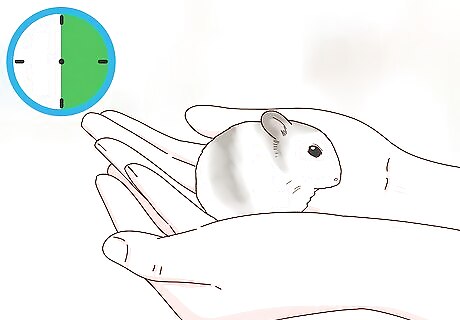
Spend at least 30 minutes a day with your hamster once it's comfortable. In order to socialize your hamster and keep it feeling comfortable, you should spend time with it every day. While you might want to keep your sessions short to start with, work your way up to 30 minutes or even longer as your hamster starts to enjoy your company more. You can also introduce your hamster to an exercise ball or playpen once it’s comfortable.

Check your hamster’s health every time you handle it. Every day when you play with your hamster, check it to make sure it looks healthy and alert. If your Winter White seems sick or its behavior changes suddenly, take it to the vet right away. Some signs of poor health in a dwarf hamster include having a wet tail, bald patches, loss of appetite, chewing its limbs, or discharge around its nose or eyes. If you notice any of these, call your veterinarian and make an appointment. Changes in your hamster’s eating, drinking, or bathroom habits can also be signs of illness. If your hamster isn’t moving and it's been very cold in your house, move the hamster's cage somewhere warm. Your hamster might have gone into hibernation.
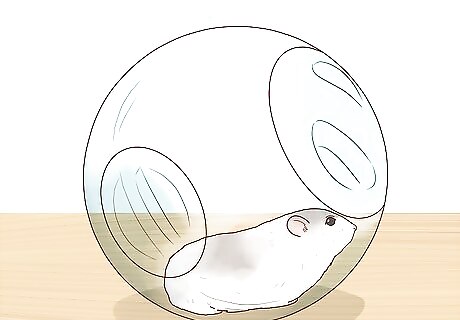
Place your hamster in a playpen or ball a few times a week for exercise. Make sure your hamster has a safe place to play so it gets all the exercise it needs. Either provide it with a playpen or a sturdy exercise ball, then let it play for about 15-20 minutes at a time, 3-4 times a week. Longer or more frequent play periods could cause your hamster to become stressed. One option for a playpen is to place a thick towel on the floor of your bathtub, along with a wheel, chew toys, and a food and water bowl. Just make sure there’s no water in the bathtub, and there’s a cover over the drain. Only use an exercise ball on a carpet or rug. On hard floors, your hamster could get too much speed and accidentally get injured. Never try to force your hamster into an exercise ball. Also, don't put your hamster into an exercise ball when it's sleepy. Always watch your hamster the whole time it's out of its cage.

Secure the door when you put your hamster back in its cage. Your Winter White may be cute, but it’s also a cunning escape artist. Always double-check the door when you close it. Otherwise, your hamster might take an overnight trip around your home, where it could get lost or hurt. If your cage door gets damaged, replace the cage as soon as possible.
Feeding the Hamster

Feed your hamster about a tablespoon (10 g) of seed mix daily. You can find a suitable seed mix anywhere hamster supplies are sold. Look for one that’s high in protein, fiber, and fat. You can either feed your hamster all of its food in the evening, or you can give it a little food in the morning and the rest at night. Although they’re nocturnal, hamsters do wake up for snacks during the day.
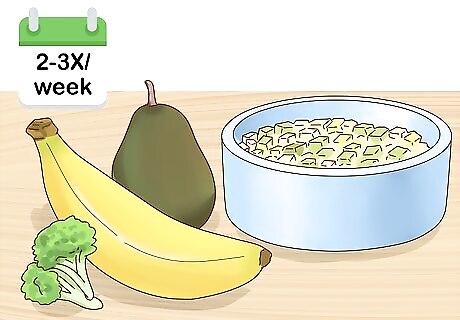
Offer small cubes of fruit or vegetables 2-3 times a week. Fruits and vegetables tend to be high in sugar, but they make great occasional treats. A few times a week, offer your hamster a few bites of a healthy snack like cauliflower, broccoli, diced pears, or banana. Sugar isn’t good for your Winter White, because they tend to develop diabetes. Hamsters especially love carrots, but since they’re high in sugar, they should only be offered once in a while. Avoid almonds, as they contain cyanic acid, which can be dangerous. If you have multiple hamsters, give them all treats at the same time so they don't become competitive. Never give your hamster anything sticky. It could get caught in their cheek pouch, causing an injury.

Offer protein-rich snacks like mealworms or bits of boiled eggs once a week. Your hamster’s food should already have protein in it, but a protein snack once a week will make sure your hamster is getting the nutrients it needs. You can place mealworms in the hamster’s food tray, or you can give it bite-sized crumbles of boiled eggs instead. Each morning, remove any bits of uneaten food so they don’t rot.
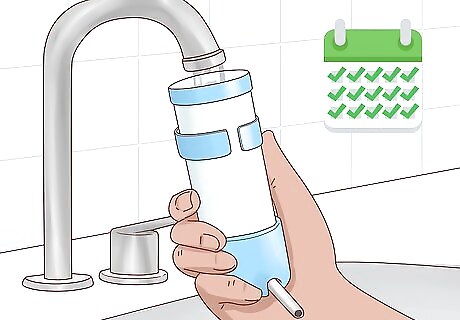
Check your hamster’s water daily. At least once a day, check your hamster’s water bottle to make sure it’s full and the water looks clear and fresh. If you notice the water looking cloudy or you see anything floating in the water, empty the bottle and wash it out, then refill it with fresh water. If you live in a place where the water is highly chlorinated, use bottled water for your hamster.
Cleaning the Cage
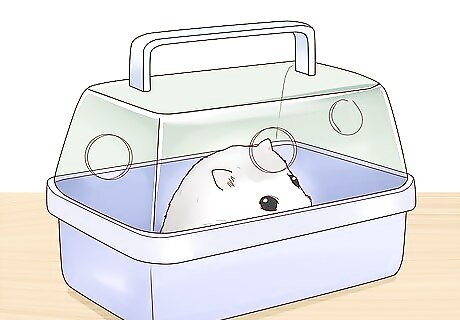
Place the hamster in a small animal carrier for cleanings. Before you try to clean your hamster’s cage, pick the hamster up and gently place it in an animal carrier, like you would use to take it to the vet. This will keep your hamster from getting unnecessarily stressed during the cleaning. You can find a carrier at a pet store. Make sure it’s designed for small animals like dwarf rodents; otherwise, it might have gaps that allow your hamster to escape.

Remove droppings from the cage daily. Each day, put on a pair of latex or rubber gloves and remove any droppings and damp bedding from the cage. If you allow these to stay in the cage, it could cause your hamster to become very sick. Hamster droppings look like small pellets. Wearing gloves will help keep you from getting sleep.

Clean the whole cage once a week. To clean the cage, take out every component and clean it individually, including the wheel, food bowl, bathroom tray, and chew toys. Then, empty out the bedding. Reserve just a little of the cleanest bedding, then throw away the rest. To make it easy to remember when to clean your hamster cage, try to do it at the same time every week. For instance, you might choose Saturday mornings when you would normally be playing video games.
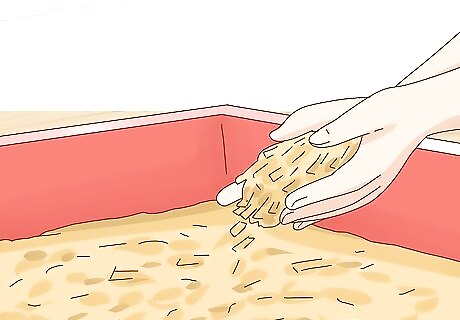
Add a little of the old bedding back when you’re finished cleaning. When you’re adding the new bedding, mix the old, clean bedding that you reserved. That way, when you put your hamster back into its cage, it will return to a familiar scent.




















Comments
0 comment